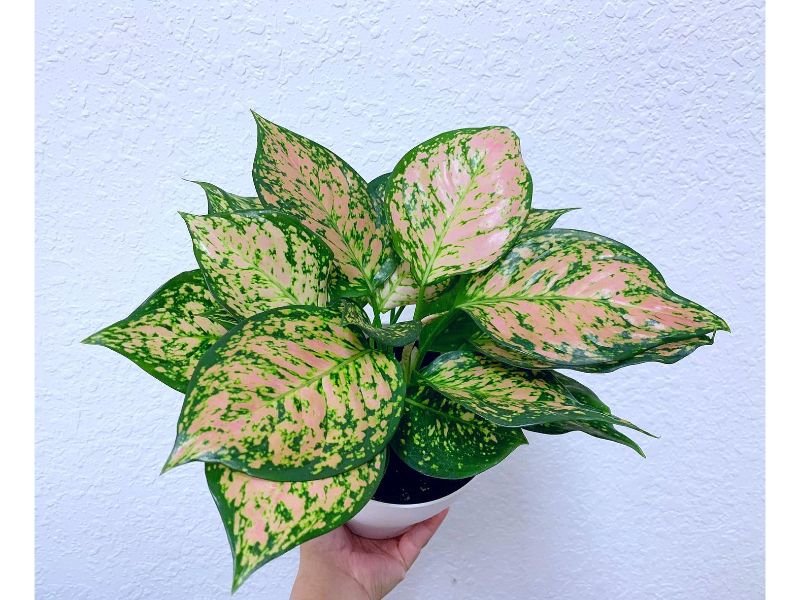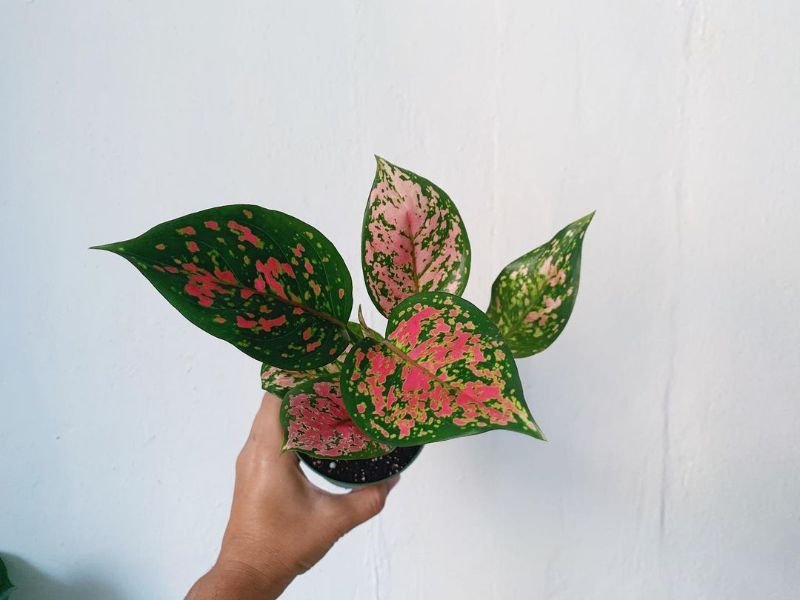Aglaonema Favonian, also known as Lady Valentine or Philippine Evergreen, is a species of perennial plant that belongs to the family Araceae. This stunning plant is native to the humid tropical rainforests of the Philippines and other parts of Southeast Asia. The name “Aglaonema” comes from two Greek words, “aglaos” meaning bright, and “nema” meaning thread or filament, which refers to the bright yellow stamen that rises from each flower.

Table of Contents
Definition of Aglaonema Favonian
Aglaonema Favonian is a beautiful evergreen houseplant known for its lush green foliage with silver-white markings. It has a unique pattern on each leaf making it a striking addition to any indoor garden. This plant can grow up to 3 feet tall and 2 feet wide, making it ideal for use in large containers as well as in groups with other plants.
Importance of Aglaonema Favonian in the plant world
In addition to being an aesthetically pleasing ornamental houseplant, Aglaonema Favonian has numerous benefits for human health and well-being. Scientific studies have shown that plants like Aglaonema are natural air purifiers that can remove harmful chemicals like formaldehyde and benzene from indoor air.
Furthermore, this plant also helps improve mental health by reducing stress levels and increasing productivity in workplaces or homes where it is present. All these benefits make Aglaonema Favonian an excellent choice for anyone looking to add some greenery to their home or office space while also improving their overall health and well-being.
Characteristics of Aglaonema Favonian
Physical Appearance
Aglaonema Favonian, also known as the Chinese Evergreen or Lady Valentine, is a beautiful tropical plant with stunning leaves that are variegated in shades of green and silver. Its leaves are large, broad, and oval or elliptical-shaped with pointed tips. The leaves may have white or light green streaks running down the center of them.
In some cases, they may be completely silver or completely green. The stem of this plant is usually thick and woody with some visible nodes on it.
Growth Habit
Aglaonema Favonian grows up to 2-4 feet in height and tends to be bushy in appearance. As an evergreen plant species, it retains its leaves throughout the year without shedding them seasonally.
It grows best when placed in a well-draining soil mix that holds moisture but does not get waterlogged or overly dry. This species of Aglaonema can grow easily indoors as a potted specimen or as part of a mixed container planting.
Light and Temperature Requirements
This species prefers bright but indirect light conditions; direct sunlight can burn its leaves quickly. It thrives at temperatures between 60°F to 86°F (15°C to 30°C) which makes it perfect for indoor cultivation throughout most parts of the world.
Aglaonema Favonian is known for its tolerance to low-light conditions which makes it ideal for spaces like offices. Overall, Aglaonema Favonian is an attractive ornamental houseplant that deserves attention from anyone seeking to add a touch of natural beauty to their home décor.
How to Care for Aglaonema Favonian

Soil and Watering Needs: Finding the Perfect Balance
Aglaonema ‘lady valentine’ Favonian thrives in well-draining soil that is rich in nutrient content. In order to ensure the proper growth of this rare plant, it is important to find a balance between overwatering and underwatering. Overwatering can lead to root rot, while underwatering can cause the leaves to dry out and become crispy.
Water the plant once a week, ensuring that there is no standing water in the pot. The top layer of soil should be slightly damp, but not wet.
If it feels dry to the touch, it’s time to water again. During periods of hot weather or low humidity levels, you may need to increase watering frequency.
Fertilization Requirements: Giving Your Plant Important Nutrients
Aglaonema Favonian requires regular fertilization in order to thrive. During its growing season (spring and summer), fertilize with a balanced liquid fertilizer every two weeks.
Be sure to dilute the fertilizer as directed on the package label. During winter months when growth slows down, reduce fertilization frequency by half or completely stop fertilizing until spring arrives again.
Pruning and Propagation Techniques: Maintaining Health and Propagating Your Plant
Pruning your Aglaonema Favonian plant helps maintain its health by removing dead or damaged leaves as well as promoting new growth. Use sharp pruning shears or scissors to remove any yellow or brown leaves at their base.
Propagating Aglaonema Favonian is possible through stem cuttings taken during the spring or summer months. Cut 6-8 inch sections from healthy stems with several leaves attached and place them in water until roots begin growing out from nodes along the stem.
Once roots have developed, plant the cuttings in well-draining soil, water them, and cover them with a plastic bag to create a humid environment. After 4-6 weeks, the cuttings should have been rooted and can be transferred to a larger pot.
The rarity of Aglaonema Favonian

Distribution and Habitat
Aglaonema Favonian is a rare species of plant that is native to the rainforests of Southeast Asia. It is found in countries such as Thailand, Malaysia, Indonesia, and the Philippines.
The plant grows at an altitude of 200 to 1,300 meters above sea level in tropical rainforest areas with moderate humidity and abundant rainfall. In its natural habitat, Aglaonema Favonian thrives in the understory layer of the forest floor.
It prefers shaded areas with indirect light as it cannot tolerate direct sunlight. The plant also requires well-drained soil that is rich in organic matter.
Threats to its Survival
The survival of Aglaonema Favonian is threatened by various factors such as habitat destruction, over-harvesting for ornamental purposes, and climate change. Due to deforestation for agriculture and development purposes, large areas of tropical forests have been cleared which has led to a decline in the population of Aglaonema Favonian. The plant’s popularity among collectors has also contributed to its decline because it has resulted in over-harvesting from the wild.
This practice not only affects the population but can also lead to genetic loss when plants are propagated without regard for genetic diversity. Climate change also poses a threat as changes in temperature and rainfall patterns can negatively impact the plant’s growth and survival.
Conservation Efforts
Efforts are being made by botanists and conservation organizations to protect Aglaonema Favonian from extinction. One way this is being done is through conservation education programs that aim to raise awareness about rare plants like Aglaonema Favonian, their importance in ecosystems, and their cultural value.
Another approach involves establishing protected areas where these plants can grow and thrive. This includes the establishment of botanical gardens, national parks, and nature reserves that provide a safe haven for rare plants.
Ex-situ conservation efforts have also been made through the cultivation and propagation of the plant in nurseries and greenhouses. Aglaonema Favonian is a rare and threatened plant species that require urgent attention from conservationists around the world.
The continued destruction of its habitat, over-harvesting, and climate change pose significant threats to its survival. It is crucial that we take action to protect this valuable plant through education, habitat protection, and ex-situ conservation efforts.
Price Range for Aglaonema Favonian
Aglaonema Favonian is a rare and highly sought-after variety of Chinese evergreen. Due to its unique appearance and difficulty in growing, it has a higher price range compared to other varieties of aglaonema. The price range for aglaonema favonian can vary greatly depending on the size, health, and rarity of the plant.
On average, a small potted aglaonema favonian can cost around $50-$100. However, larger or more mature plants can cost upwards of $300-$500.
It’s important to note that some sellers may charge even more depending on the demand and availability of the plant. Factors that Affect the Price Range
Factors that Affect the Price Range
Several factors can affect the price range for aglaonema favonian. One significant factor is its rarity.
As mentioned earlier, this variety is not commonly found in nurseries or garden centers, making it challenging to obtain. Additionally, it takes several years for an aglaonema favonian to grow to maturity and develop its unique foliage pattern.
Another factor that affects the price range is the overall health and condition of the plant. Healthy plants are more expensive as they require proper care and attention from growers.
The size of the plant also plays a role in determining its value as larger plants take up more space and require more resources to maintain. Where to Buy Aglaonema Favonian
Where to Buy Aglaonema Favonian
Finding aglaonema favonian can be challenging as it’s not widely available in most nurseries or garden centers. However, there are several online marketplaces where you can purchase this rare variety from trusted sellers.
Some popular websites where you can buy aglaonema favonian include Etsy, eBay, and Amazon. It’s essential to do your research and read reviews from other buyers before purchasing from any online seller.
You can also try contacting local growers or plant communities to see if they have aglaonema favonian available for sale. Joining social media groups or forums dedicated to rare plants is another great way to connect with growers and collectors who may have this variety in their collection.
Conclusion
Aglaonema ‘lady valentine’ Favonian is an exotic plant that is gaining popularity among indoor gardeners. It has a unique and striking appearance, making it a great addition to any home or office. The plant’s low maintenance requirements make it ideal for those who are new to taking care of plants or those with busy schedules.
Aglaonema Favonian is a rare and valuable species that can make a great asset to your collection. With proper care, it can thrive in any environment, whether at home or in the office.
While its price range might be higher than other plants, it is worth investing in due to its rarity and beauty. As more people become aware of this unique plant species, we are likely to see an increase in demand for Aglaonema Favonian in the future.
Summary of Key Points about Aglaonema Favonian
Aglaonema Favonian is a fascinating plant species that offers many benefits to indoor gardeners. From its striking appearance to its low maintenance requirements, there are many reasons why this plant deserves our attention.
One of the most notable characteristics of Aglaonema Favonian is its physical appearance. With stunning variegated leaves that feature shades of green and silver, this plant can easily become the centerpiece of any room.
Another key point to note about Aglaonema Favonian is how easy it is to take care of. With minimal watering and fertilization needs, this plant can survive even if you forget about it for days at a time.
We cannot ignore the rarity factor when discussing Aglaonema Favonian. This unique species is not commonly found on the market or in nurseries, which makes it even more special and valuable for collectors.
Future Prospects for the Plant
As we have discussed throughout this article, Aglaonema Favonian is a special and rare plant that continues to gain popularity in the indoor gardening community. With its unique look and low maintenance requirements, we are likely to see an increase in demand for this species in the future.
Additionally, as more people become aware of Aglaonema Favonian and its value, we can expect to see more efforts towards the conservation and protection of this species. With increased awareness comes greater appreciation, which can help ensure that Aglaonema Favonian remains a part of our natural world for years to come.

Gardening is my passion and growing plants indoors has always been a stress relief for me. Grow a banana tree in my apartment once (although failed to produce bananas).






